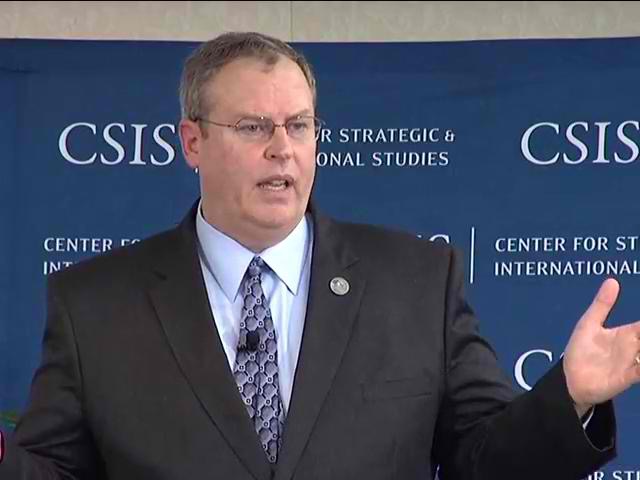
Robert Work
CLARIFIED To Reflect Approved Versus Draft Recommendations Not Approved.
WASHINGTON: A new Technology Competitiveness Council led by the vice president is needed to spur the rapid proliferation of AI capabilities across America to outpace China, says the National Security Commission on Artificial Intelligence.
“We are in an an innovation competition” with China “unlike anything we’ve ever seen before,” Bob Work, former DoD deputy secretary, told reporters in a conference call today. “China is trying to become a technological hegemon and AI is … leading their efforts. We have to have good government oversight and direction on how we approach that competition.”
Modeled on the National Space Council now chaired by Vice President Mike Pence, the commission says a new White House-level effort must develop a “comprehensive technology strategy” and keep up pressure on DoD, the Intelligence Community and other federal agencies to provide funding and bureaucratic support for needed changes.
CLARIFICATION BEGINS. The bi-partisan commission, mandated by Congress in the 2019 National Defense Authorization Act (NDAA), released its third-quarter recommendations, approved by the commissioners (who include many tech industry representatives) on Oct. 8. CLARIFICATION ENDS. The recommendations include focusing on three key areas:
“1) Supporting the growth of nationwide AI R&D through novel funding mechanisms;
2) Posturing the defense and intelligence AI R&D communities to address national-security specific problems and capabilities through establishment of a modern digital ecosystem; and,
3) Expanding the role of industry in the DoD’s AI R&D to pursue next-generation capabilities.
Commission Chairman Eric Schmidt, former CEO of Google, told reporters today that the timing of the new set of the recommendations was deliberately aimed at influencing this year’s NDAA — an effort he said the commission has had some success at. “It’s gone remarkably well,” he said.
But perhaps more importantly, the commission has its eye on both the Trump and Biden presidential campaigns, he said. The idea is to ensure that whoever wins the November election is ready to put into place new ideas for bolstering US AI competitiveness. “We want to make sure that they’re up and ready to fly,” he said.
The final report, he said, is being targeted for release in March — after the next administration (whomever wins) has had some time to settle in.
The commission last November released an initial set of recommendations, including the controversial assertion that the Pentagon embrace truly autonomous weapons. In July, it released its second-quarter set of some 35 more recommendations, including pushing DoD to adopt commercial AI systems and a number of options for helping the services speed up their own AI development work.
This iteration of the report contains seven potential options (with the report noting that the recommendations are not mutually exclusive) for elevating the role played by the Pentagon’s Chief Technology Officer (CTO) and the Office of the Undersecretary for Research & Engineering (USDR&E).
In that section, the commission says that the DoD R&E undersecretary “should be appointed the Co-Chair and Chief Science Advisor to the Joint Requirements Oversight Council (JROC) for Joint and cross-domain capabilities.” Further, that office should be granted a special funding pot “to mature, operationally prototype, and transition exceptionally promising AI-enabled technologies,” the report says.
The commission also recommends that a position similar to the Pentagon’s CTO should be created within the Intelligence Community. “Within the Office of the Director of National Intelligence (ODNI), the Director of S&T should be designated as the IC’s CTO and empowered to enable the IC to adopt AI-enabled applications to solve operational intelligence requirements,” the report says. This, Work explained, is to help DoD and the IC to coordinate more closely together at senior levels on AI initiatives.
The report further makes three recommendations for the Pentagon to expand industry’s role in developing next-generation military AI capabilities:
- Communicate DoD Modernization Priorities to Industry through Issuance of Technology R&D Objectives. The report says that USDR&E should develop the objectives, and ensure that they are aligned with the Technology Annex to the National Defense Strategy.
- Strengthen Return on Small Business Innovation Research (SBIR) Investments. This should include, the report says, “Optimize the DoD’s SBIR program to more effectively develop and deploy AI solutions to meet warfighter needs. Enable successful prototypes to scale through sufficient funding, early access to customers and operators, and better due-diligence.”
- Launch an AI Catalyst Initiative, “to accelerate private-sector research into longer-time horizon, next-generation AI-enabled defense capabilities.”
Lastly, this version of the report includes a number of recommendations for diplomatic efforts to bring US allies into the competition against China. This includes pushing DoD and the State Department to “provide clear policy guidance and resource support to NATO’s AI initiatives” in hopes of accelerating the integration of AI with allied militaries.
“We’ve come to the view, which I think is self evident, that we’re not going to win without very, very strong partners,” Schmidt said.
CLARIFICATION BEGINS: The initial third-quarter draft also recommended that the US adopt an “offensive approach” to countering to counter “malign information operations” by China and Russia, including via the creation of a “Malign Information Detection and Analysis Center (MIDAC)” controlled by the US government and “staffed by an elite team of intelligence analysts.” The MIDAC would “trace and attribute malign information produced by U.S. adversaries.” However, that set of draft recommendations was not approved by the commissioners. CLARIFICATION ENDS.
Norway’s top officer on his ‘biggest challenge,’ next frigate and new NATO neighbors
Gen. Eirik Kristoffersen, Norway’s Chief of Defense, talks to Breaking Defense about his plans for spending on new frigates and subs, the challenges of upgrading Norway’s “digital backbone” and refilling the military’s stocks.



























